Multi-Objective Optimization Design of Vehicle Side Crashworthiness Based on Machine Learning Point-Adding Method
Abstract
1. Introduction
- Using ABRF neural network and OLHS to establish the first generation metamodel, the NSGA-II optimization algorithm is then used to obtain the Pareto, and the MLPA is combined to dynamically improve the accuracy of this surrogate model until it converges.
- Different from the traditional method of adding points, this paper mainly considers the maximum–min distance (MMD) point, the nearest boundary (NB) point and the high-quality points on the optimal front edge obtained by ARBF-MLPA. The selection of these three points helps to improve the local accuracy of the model and leads the optimization results being closer to the real front edge.
- After test functions of three different frontier features testing, the method proposed in this paper has more advantages than the traditional RBF-UDPA method in the overall convergence speed and the distribution of the final optimal front.
- The head, chest, abdomen and pelvis of the driver were corresponding to the corresponding position of the B-pillar of the car, and the amount of invasion of each part was measured indirectly by setting the spring unit at the B-pillar, so as to simulate the invasion injury suffered in the side impact of the car. The amount of chest invasion was included as one of the design variables.
- Combine the ARBF-MLPA method with the NSGA-II optimization algorithm to optimize the design for vehicle-side crash safety The optimized model reduces chest intrusion by 4.32%, peak collision force by 2.11% and reduces mass by 14.05%.
2. ARBF-MLPA Method
2.1. Design of Experiment (DOE)
2.2. Radial Basis Function (RBF) Neural Network
2.3. Multi-Objective Optimization Algorithm
- Firstly, the sample points obtained by OLHS method, and the response values obtained by finite element method, were used to construct the RBF metamodel;
- In this algorithm, the design point is the first-generation population. The population is initialized, and the offspring is obtained through crossover, selection, mutation;
- Merge the parents with the offspring and sort them non-dominated;
- After sorting according to the rank, individuals are added to the next population in order to form a new parent population, and the remaining individuals will be eliminated after the number of the next generation arrives. This is the elite retention strategy based on the calculation of crowding degree;
- If no new parent population is generated, the parent population of this generation will be sorted in a non-dominated way and a new parent generation will be formed from them. If a new parent population is created, the process of 2 to 4 is repeated until the termination condition is reached. Here, we set the maximum number of evolutionary generations as the termination condition;
- Output the Pareto front of this optimization;
- Using the MLPA method, select points in the Pareto front output from the last step. Additionally, the finite element method should be used to calculate the corresponding response values, so as to update the RBF model above.
2.4. Adaptive Radial Basis Function Neural Network Combined with Machine Learning Point-Adding Algorithm (ARBF-MLPA)
2.5. Performance Test of Optimization Algorithm
2.5.1. Test Function
2.5.2. Performance Evaluation Indicators and Convergence Criteria
2.5.3. Test of Mathematical Functions of Optimization Algorithm
3. Selection of Finite Element Model (FEM) and Selection of Optimization Objectives
3.1. Establishment of FEM for Vehicle-Side Crash
3.2. Validation of FEM
3.3. Selection of Optimization Objectives
3.3.1. The Amount of Chest Intrusion
3.3.2. Peak Value of Collision Force
4. Optimization Design of Vehicle-Side Crashworthiness
4.1. Selection of Designed Variables
4.2. Establishment of Multi-Objective Model
4.3. Model Solution
4.4. Results and Error Analysis
4.5. Computational Cost Analysis
5. Conclusions
- This paper proposed to conduct optimization design for vehicle-side crash safety using the ARBF-MLPA method combined with NSGA-II optimization algorithm; compared to traditional static metamodels, this method improves the solution-finding efficiency significantly.
- It analyzed and discussed the point-adding strategy of ARBF-MLPA method, model updating and optimizing process. Then, it validated the effectiveness and fast convergence speed of the algorithm using the mathematical examples of different optimal fronts edge.
- It conducted optimization design for vehicle-side crash using ARBF-MLPA, selected peak collision force and the amount of chest intrusion as optimization targets, reducee peak collision force and the amount of chest intrusion while ensuring lightweight of vehicles. After 6 iterations solved the model convergence, results showed that, the model after optimization has higher accuracy than finite element solution and has better crashworthiness too, while also realizing the lightweight characteristic of the vehicles.
- The ARBF-MLPA, combined with the NSGA-II optimization method described in this paper, achieved good effects in vehicle-side crashworthiness optimization analysis. In order to verify the universality of this method, it is necessary to apply this method widely to solution-finding methods of various multi-objective problems.
Author Contributions
Funding
Data Availability Statement
Conflicts of Interest
References
- Anderson, M.J.; Whitcomb, P.J. RSM Simplified: Optimizing Processes Using Response Surface Methods for Design of Experiments; Productivity Press: New York, NY, USA, 2016. [Google Scholar]
- Kleijnen, J.P.C. Kriging metamodeling in simulation: A review. Eur. J. Oper. Res. 2009, 192, 707–716. [Google Scholar] [CrossRef]
- Dongare, A.D.; Kharde, R.R.; Kachare, A.D. Introduction to artificial neural network. Int. J. Eng. Innov. Technol. 2012, 2, 189–194. [Google Scholar]
- Hardy, R.L. Multiquadric equations of topography and other irregular surfaces. J. Geophys. Res. 1971, 76, 1905–1915. [Google Scholar] [CrossRef]
- Fang, H.; Rais-Rohani, M.; Liu, Z.; Horstemeyer, M. A comparative study of metamodeling methods for multiobjective crashworthiness optimization. Comput. Struct. 2005, 83, 2121–2136. [Google Scholar] [CrossRef]
- Montgomery, D.C. Experimental design for product and process design and development. J. R. Stat. Soc. Ser. D 1999, 48, 159–177. [Google Scholar] [CrossRef]
- Forrester, I.J.A.; Keane, A.J. Recent advances in surrogate-based optimization. Prog. Aerosp. Sci. 2009, 45, 50–79. [Google Scholar] [CrossRef]
- Fang, J.; Sun, G.; Qiu, N.; Kim, N.H.; Li, Q. On design optimization for structural crashworthiness and its state of the art. Struct. Multidiscip. Optim. 2017, 55, 1091–1119. [Google Scholar] [CrossRef]
- Emmerich, M.; Naujoks, B. Metamodel assisted multiobjective optimization strategies and their application in airfoil design. In Adaptive Computing in Design and Manufacture VI; Springer: Berlin/Heidelberg, Germany, 2004; pp. 249–260. [Google Scholar]
- Jing, C.; Aotian, T.; Zhen, L.; Sen, X.; Xiaocong, C. A Multi-objective Particle Swarm Optimization Algorithm Based on Kriging Model Point Adding Strategy. J. Jilin Univ. 2020, 58, 1159–1166. [Google Scholar] [CrossRef]
- Kim, I.Y.; De Weck, O.L. Adaptive weighted-sum method for bi-objective optimization: Pareto front generation. Struct. Multidiscip. Optim. 2005, 29, 149–158. [Google Scholar] [CrossRef]
- Zhou, J.; Li, M.; Xu, M. A Novel Sequential Multi-Objective Optimization Using Anchor Points in the Design Space of Global Variables. J. Mech. Des. 2016, 138, 121406. [Google Scholar] [CrossRef]
- Sun, G.; Tian, Y.; Wang, R.; Fang, J.; Li, Q. Parallelized multiobjective efficient global optimization algorithm and its applications. Struct. Multidiscip. Optim. 2020, 61, 763–786. [Google Scholar] [CrossRef]
- Sun, G.; Wang, X.; Fang, J.; Pang, T.; Li, Q. Parallelized optimization design of bumper systems under multiple low-speed impact loads. Thin-Walled Struct. 2021, 167, 108197. [Google Scholar] [CrossRef]
- Fang, J.; Gao, Y.; Sun, G.; Xu, C.; Li, Q. Multiobjective sequential optimization for a vehicle door using hybrid materials tailor-welded structure. Proc. Inst. Mech. Eng. Part C J. Mech. Eng. Sci. 2016, 230, 3092–3100. [Google Scholar] [CrossRef]
- Yin, H.; Fang, H.; Wen, G.; Wang, Q.; Xiao, Y. An adaptive RBF-based multi-objective optimization method for crashworthiness design of functionally graded multi-cell tube. Struct. Multidiscip. Optim. 2016, 53, 129–144. [Google Scholar] [CrossRef]
- Park, G.-B.; Jeong, M.; Choi, D.-H. A guideline for parameter setting of an evolutionary algorithm using optimal latin hypercube design and statistical analysis. Int. J. Precis. Eng. Manuf. 2015, 16, 2167–2178. [Google Scholar] [CrossRef]
- Pholdee, N.; Bureerat, S. An efficient optimum Latin hypercube sampling technique based on sequencing optimisation using simulated annealing. Int. J. Syst. Sci. 2015, 46, 1780–1789. [Google Scholar] [CrossRef]
- Deb, K.; Pratap, A.; Agarwal, S.; Meyarivan, T. A fast and elitist multiobjective genetic algorithm: NSGA-II. IEEE Trans. Evol. Comput. 2002, 6, 182–197. [Google Scholar] [CrossRef]
- Ding, H.; Jianrong, Z.; Junyan, Z. A Multi-objective Optimization Method for Parallel Point Adding Strategy of Kriging Model. Mech. Sci. Technol. Aerosp. Eng. 2016, 35, 1715–1720. [Google Scholar] [CrossRef]
- Chen, G.; Han, X.; Liu, G.; Chao, J. An efficient multi-objective optimization method for black-box functions using sequential approximate technique. Appl. Soft Comput. 2012, 12, 14–27. [Google Scholar] [CrossRef]
- Lin, C.; Gao, F.; Bai, Y. Multiobjective reliability-based design optimisation for front structure of an electric vehicle using hybrid metamodel accuracy improvement strategy-based probabilistic sufficiency factor method. Int. J. Crashworthiness 2018, 23, 290–301. [Google Scholar] [CrossRef]
- Lin, C.; Gao, F.; Wang, W.; Chen, X. Multi-objective optimization design for a battery pack of electric vehicle with surrogate models. J. Vibroeng. 2016, 18, 2343–2358. [Google Scholar] [CrossRef]
- Tian, Y.; Zhang, X.; Wang, C.; Jin, Y. An Evolutionary Algorithm for Large-Scale Sparse Multiobjective Optimization Problems. IEEE Trans. Evol. Comput. 2020, 24, 380–393. [Google Scholar] [CrossRef]
- Gao, F.L.; Bai, Y.C.; Lin, C.; Kim, I.Y. A time-space Kriging-based sequential metamodeling approach for multi-objective crashworthiness optimization. Appl. Math. Model. 2019, 69, 378–404. [Google Scholar] [CrossRef]
- Yen, G.G.; He, Z. Performance Metric Ensemble for Multiobjective Evolutionary Algorithms. In IEEE Transactions on Evolutionary Computation; IEEE Neural Networks Council: New York, NY, USA, 2014; Volume 18. [Google Scholar]
- Voß, T.; Hansen, N.; Igel, C. Improved step size adaptation for the MO-CMA-ES. In Proceedings of the Genetic and Evolutionary Computation Conference, Portland, OR, USA, 7–11 July 2010; pp. 487–494. [Google Scholar]
- Zitzler, E.; Deb, K.; Thiele, L. Comparison of multiobjective evolutionary algorithms: Empirical results. Evol. Comput. 2000, 8, 173–195. [Google Scholar] [CrossRef]
- Sun, G.; Li, G.; Zhou, S.; Li, H.; Hou, S.; Li, Q. Crashworthiness design of vehicle by using multiobjective robust optimization. Struct. Multidiscip. Optim. 2011, 44, 99–110. [Google Scholar] [CrossRef]
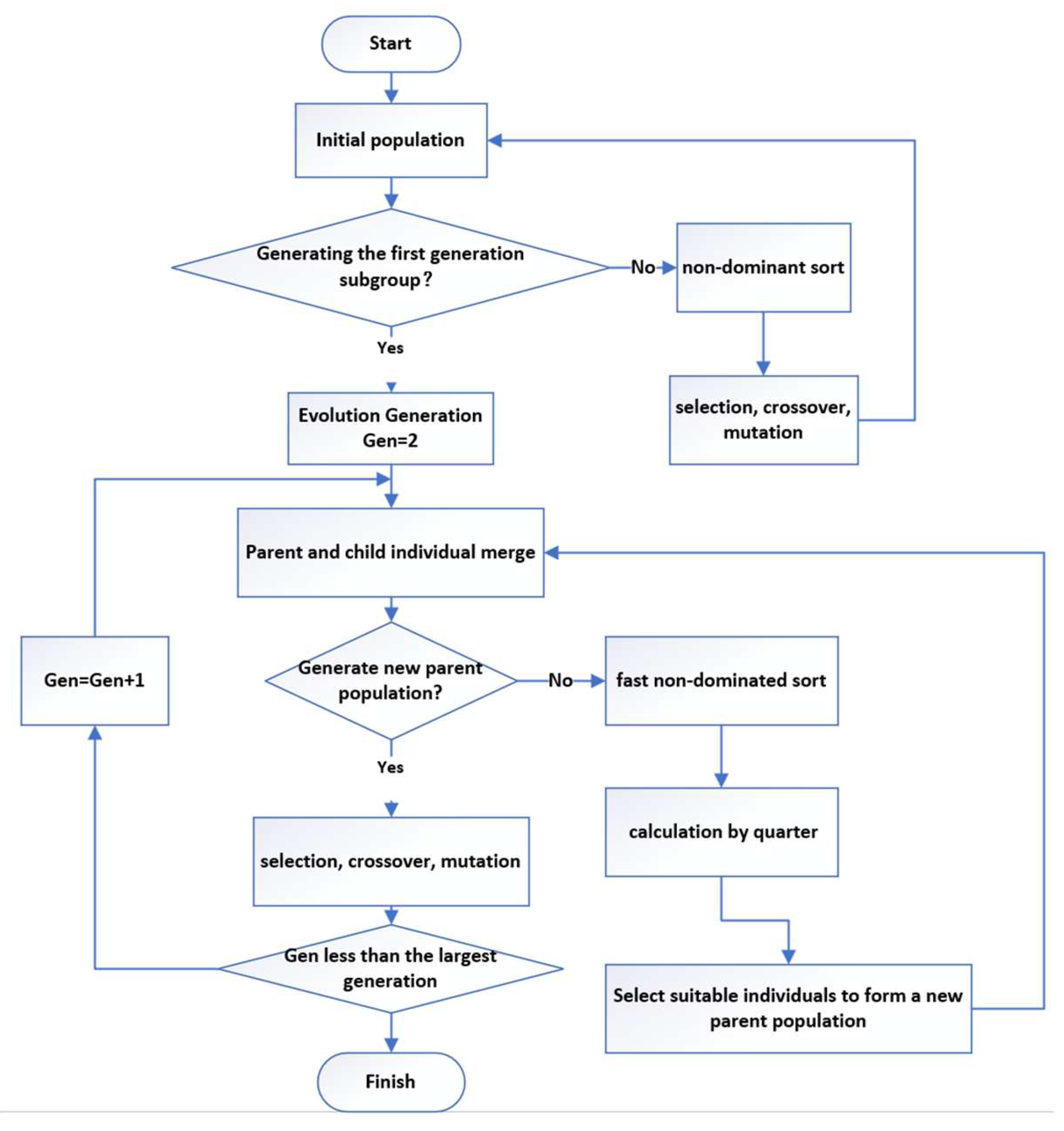

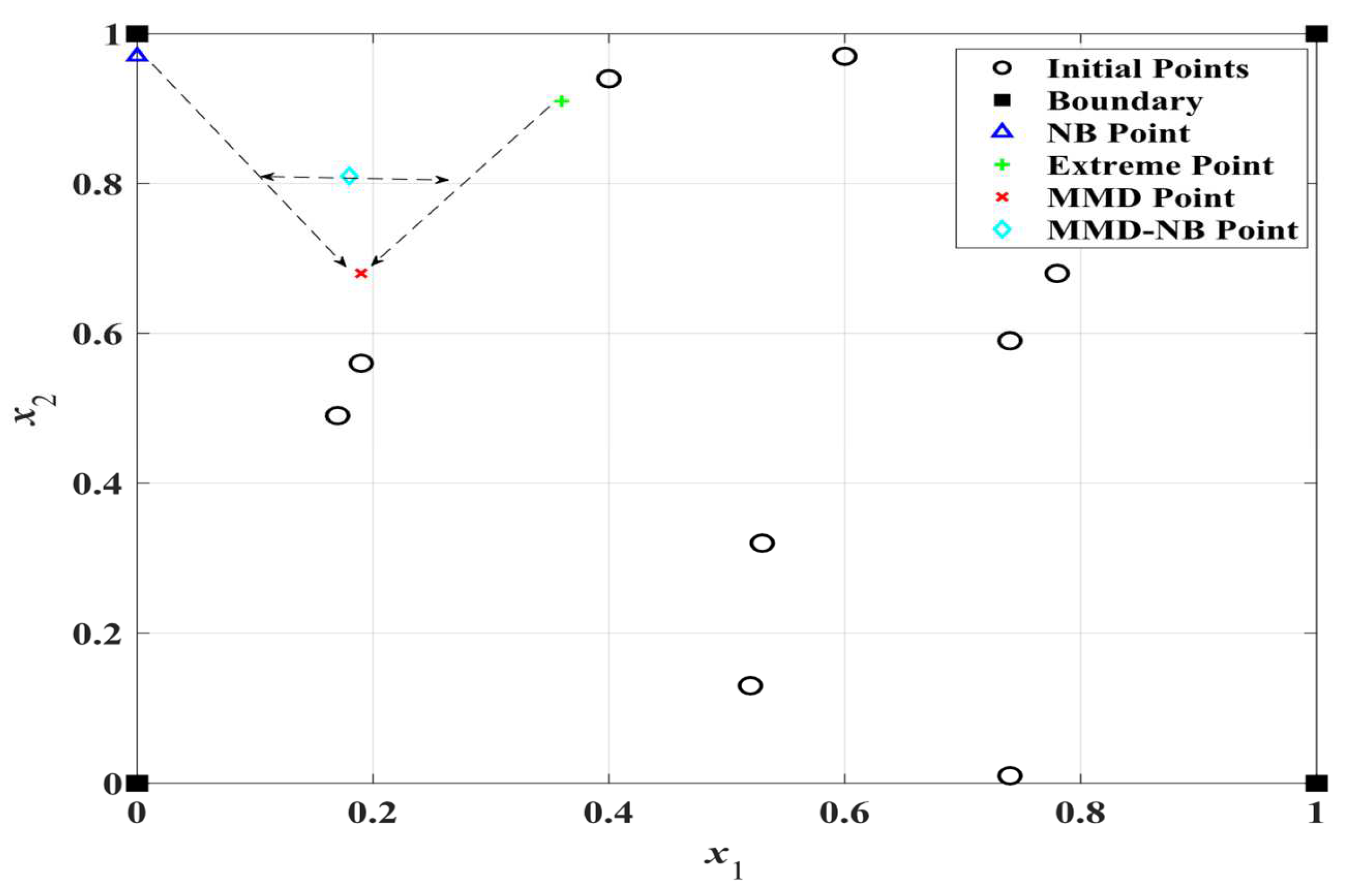
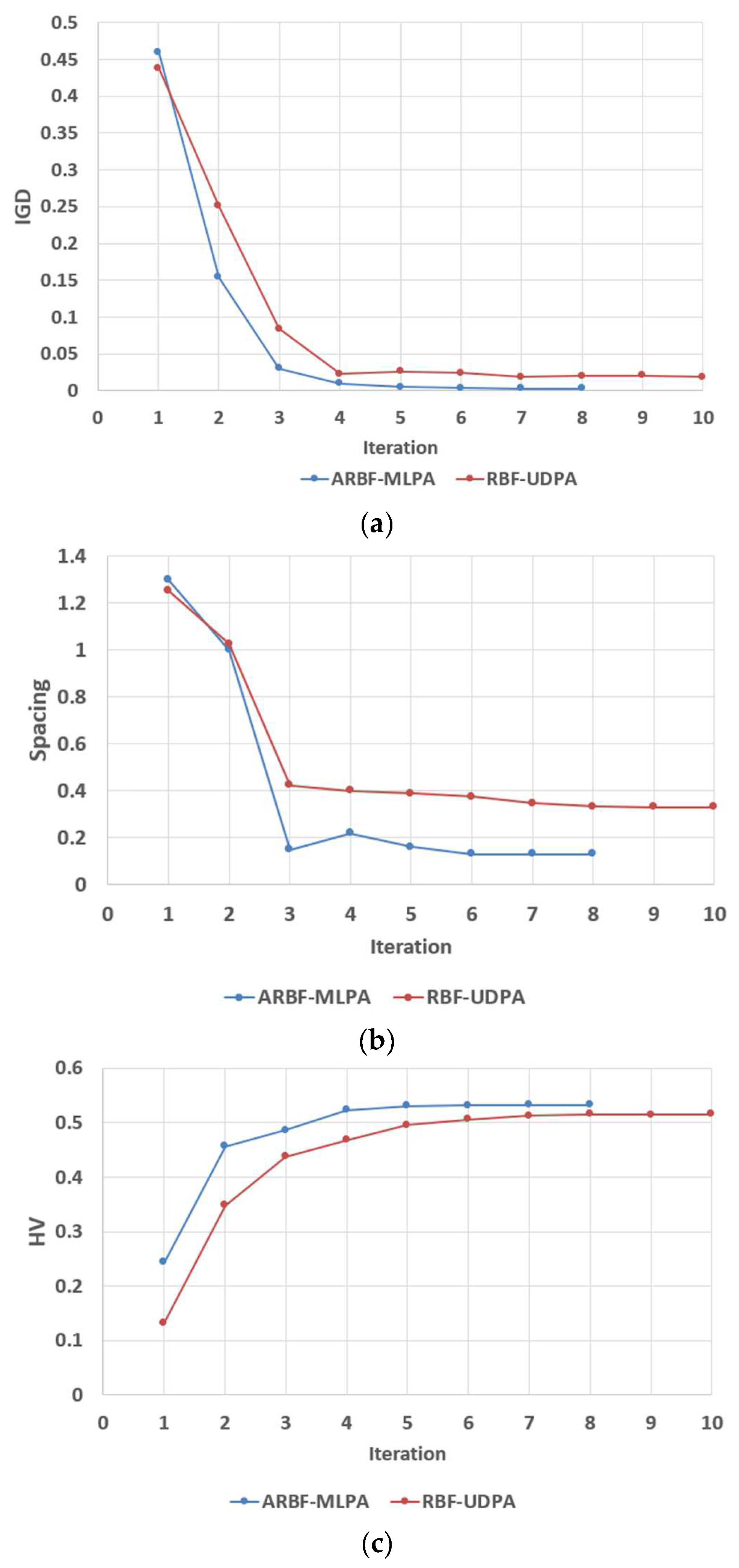
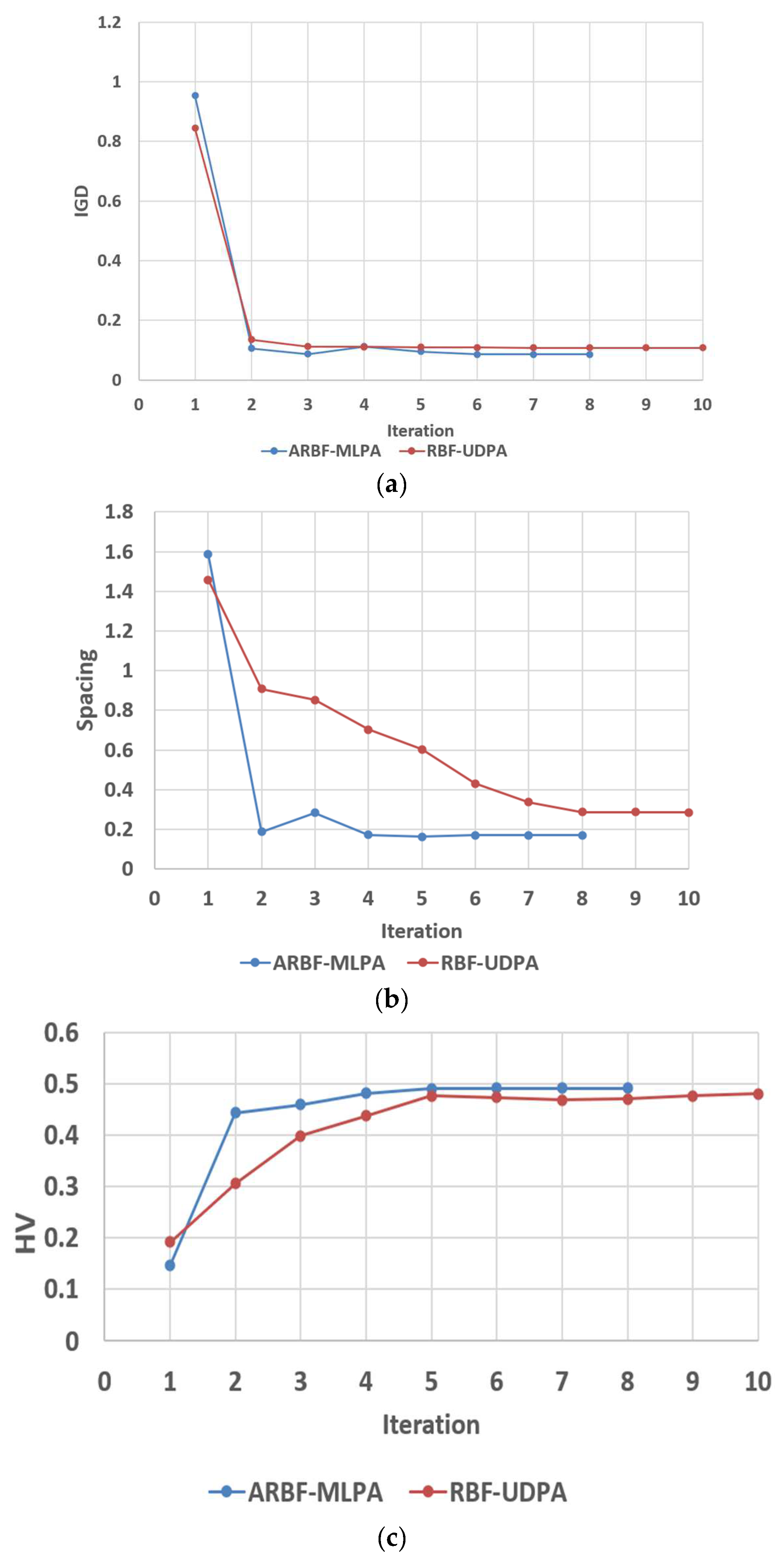


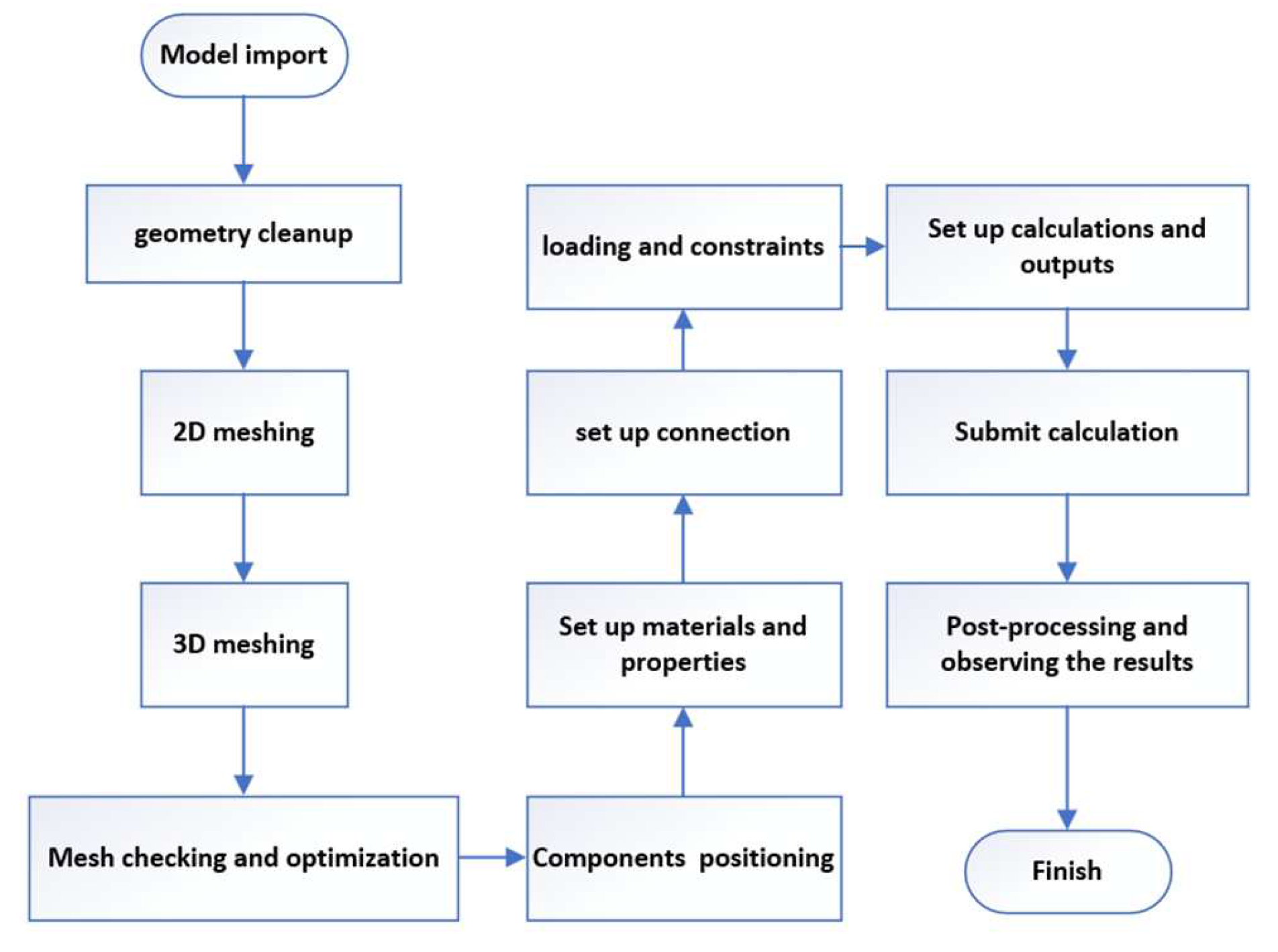

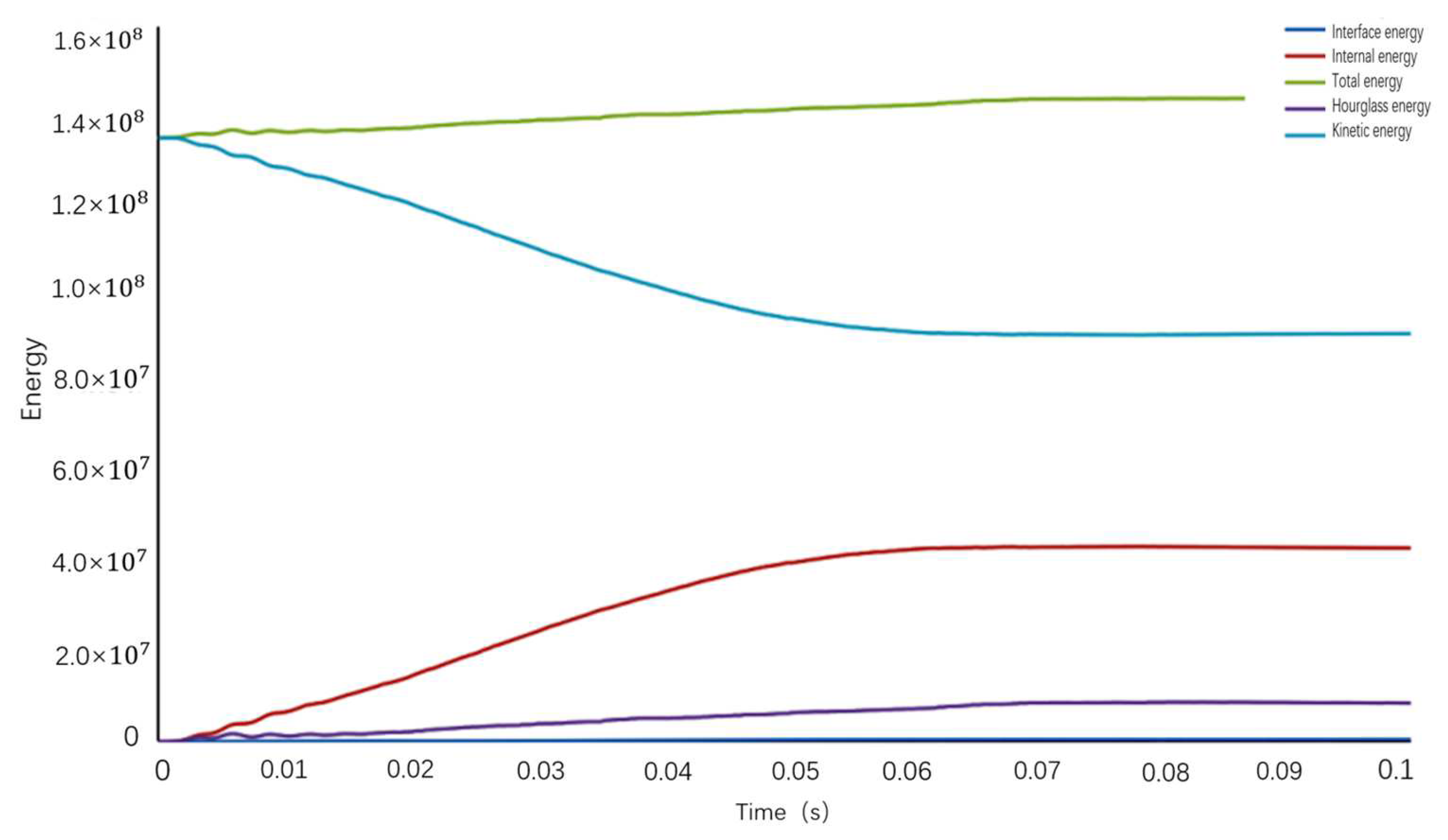
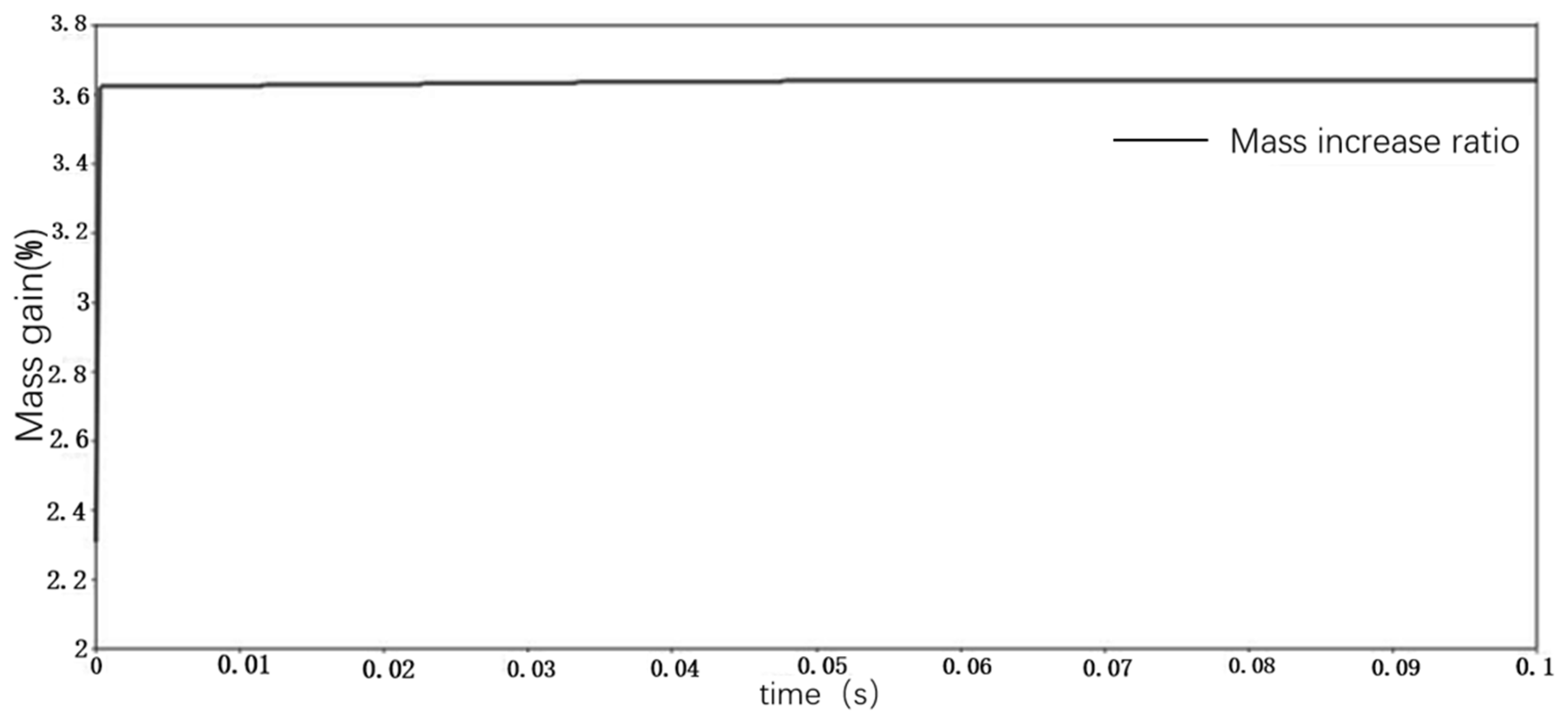
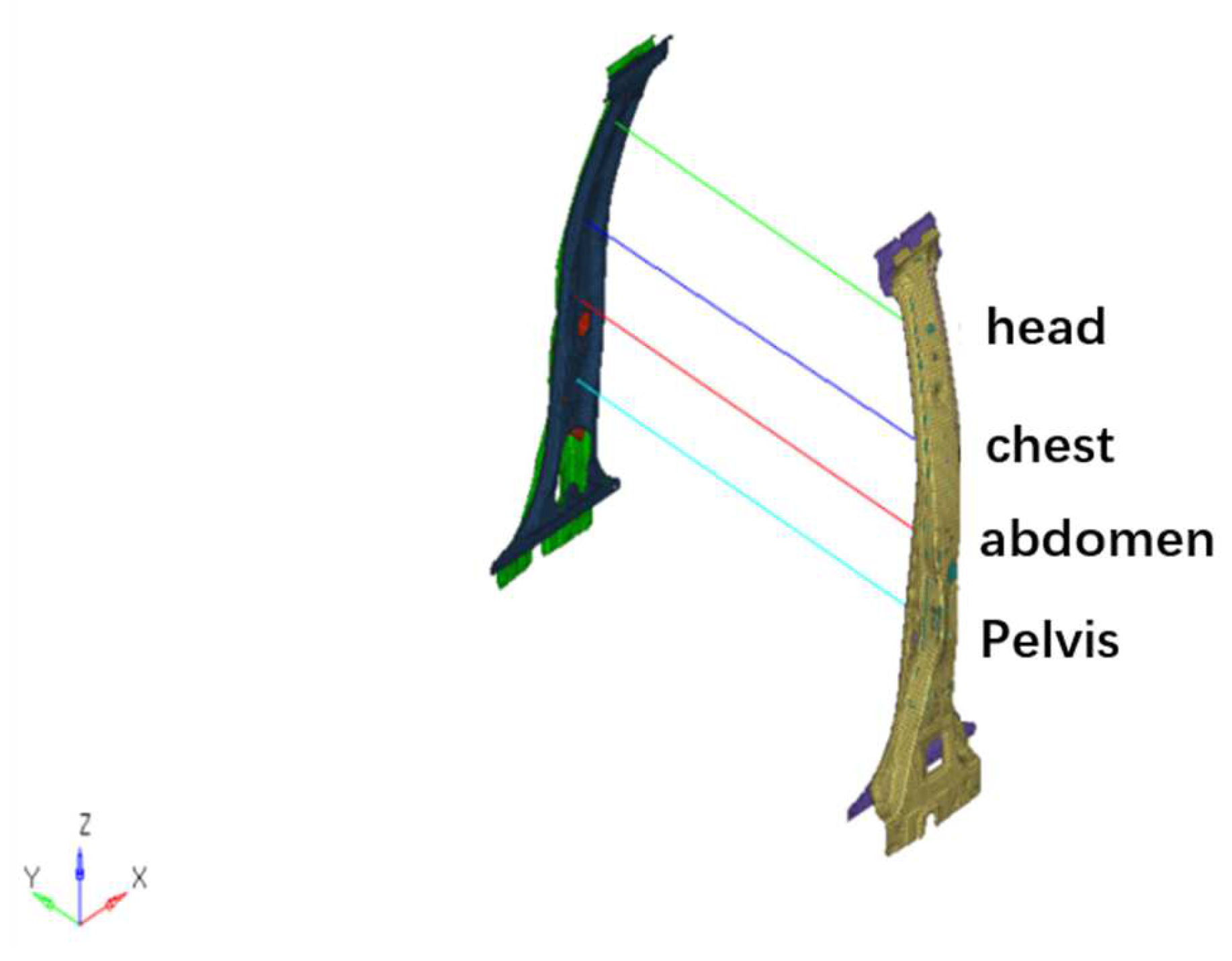


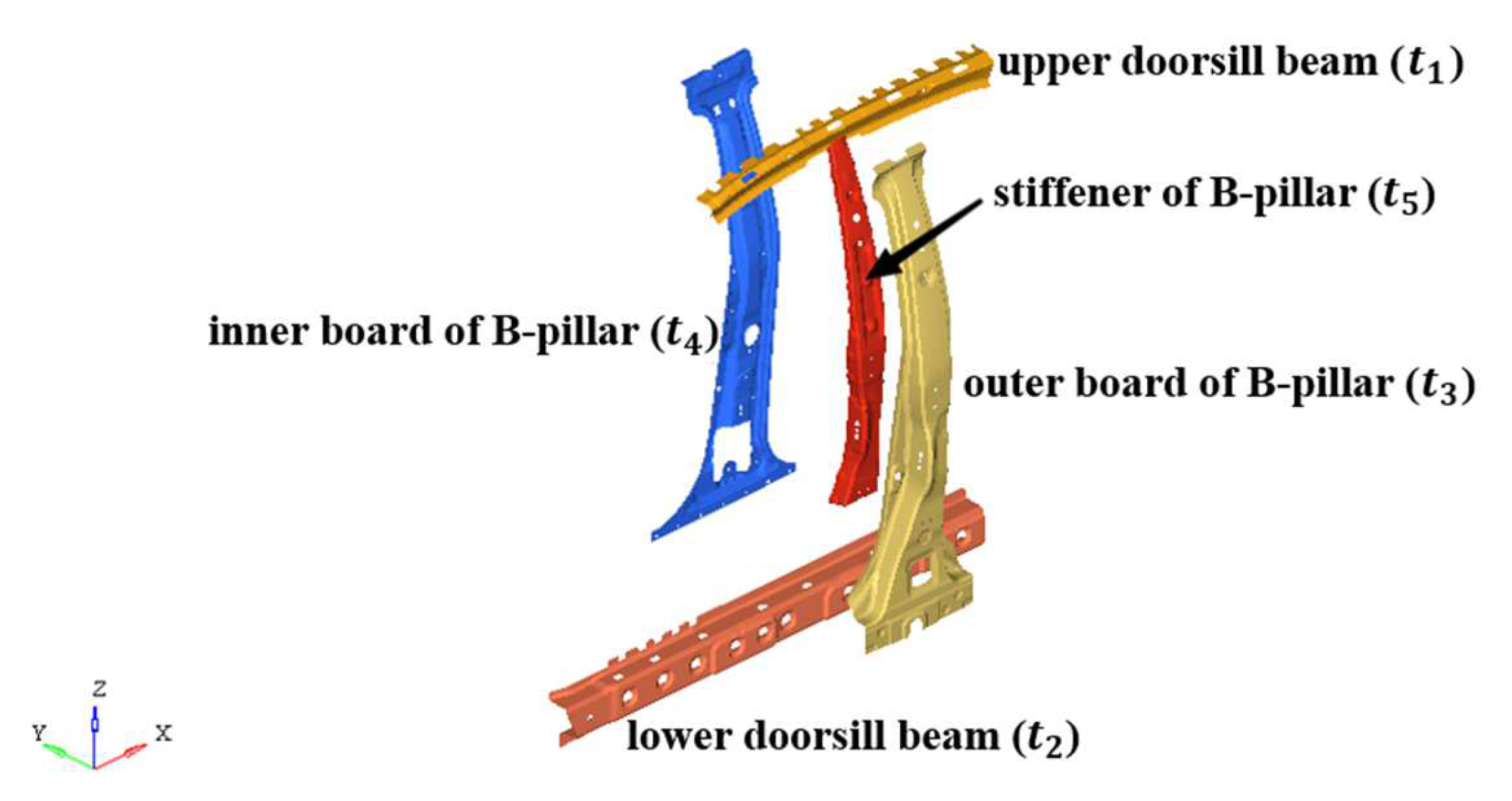
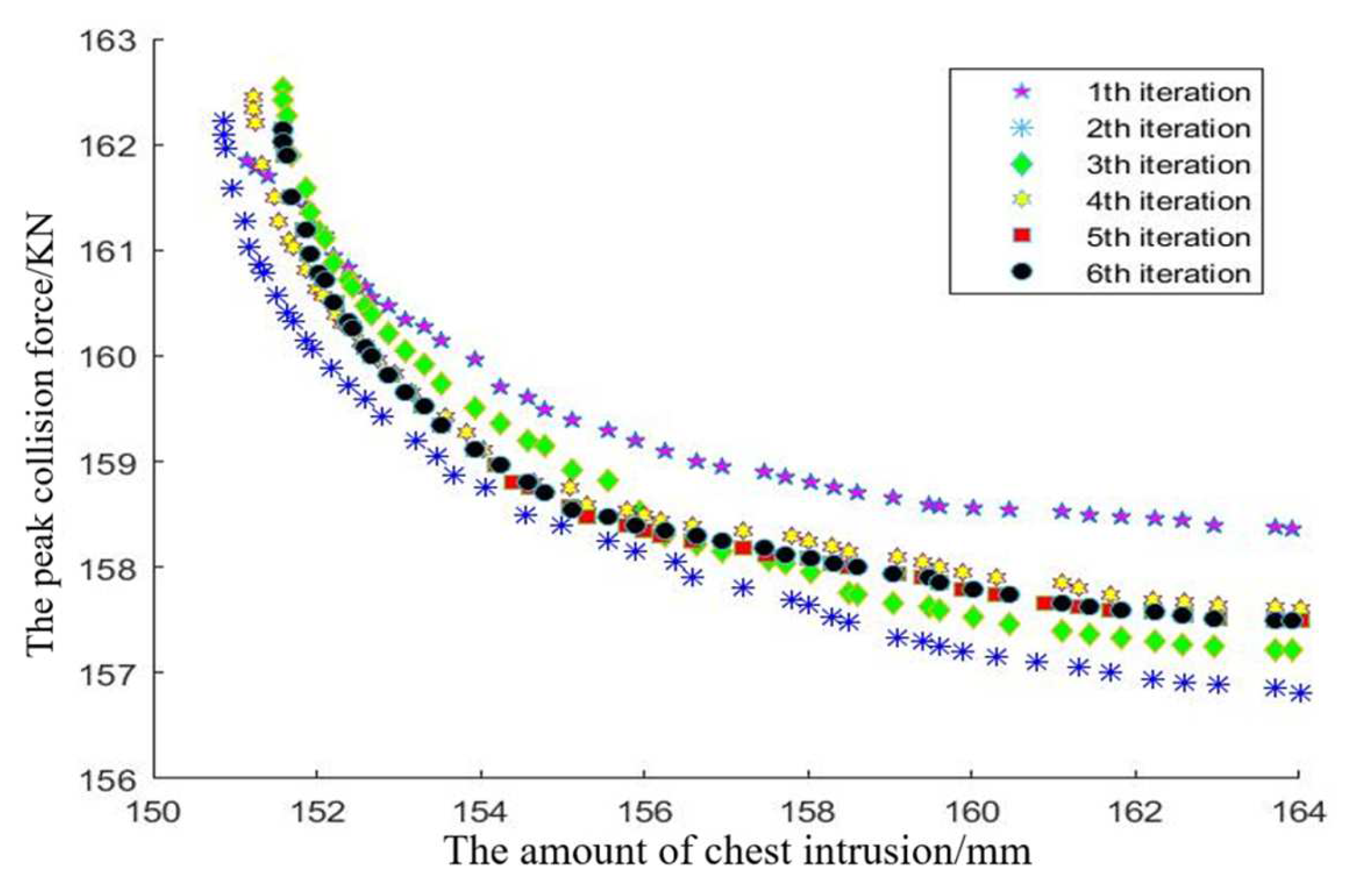
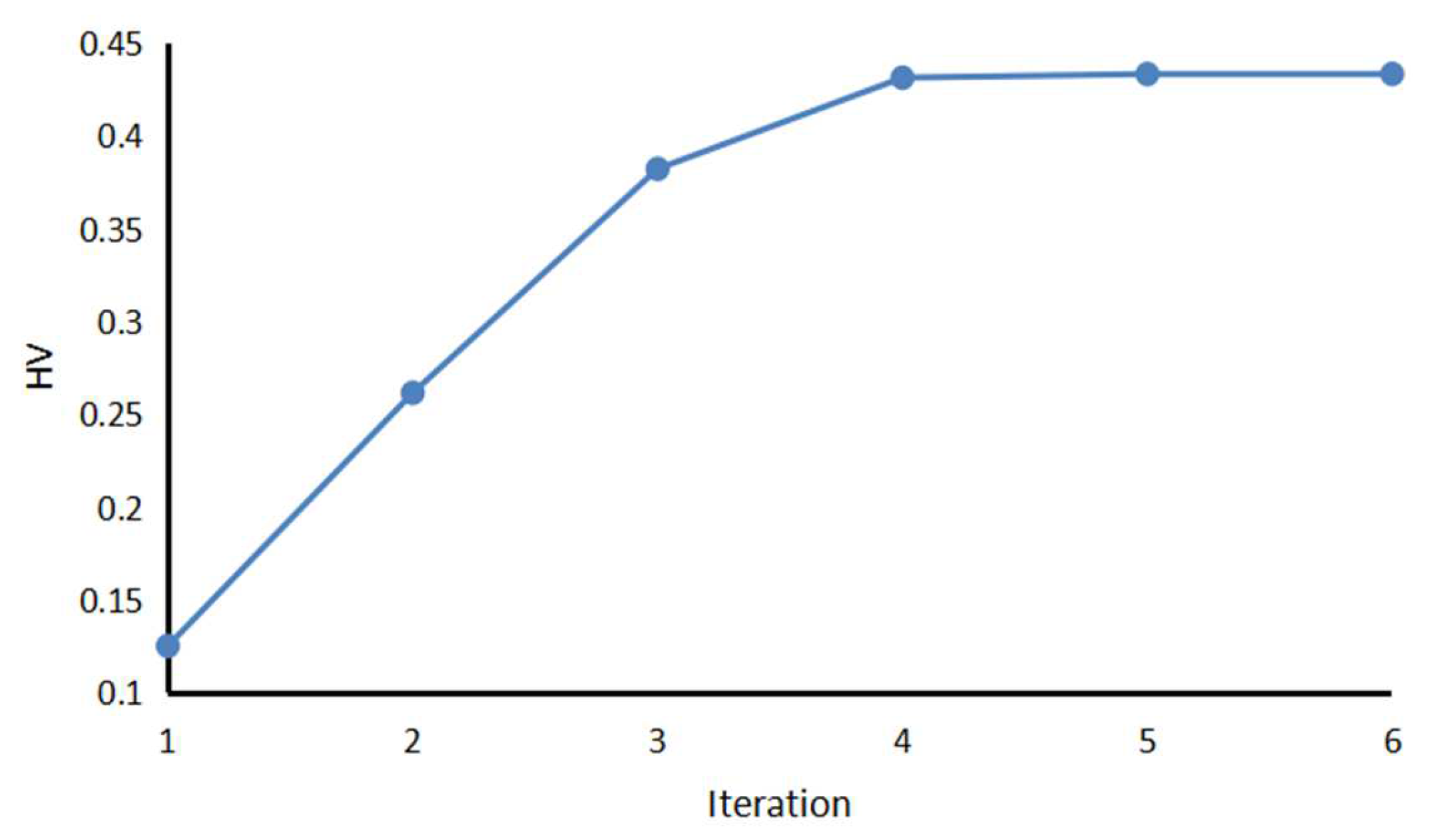
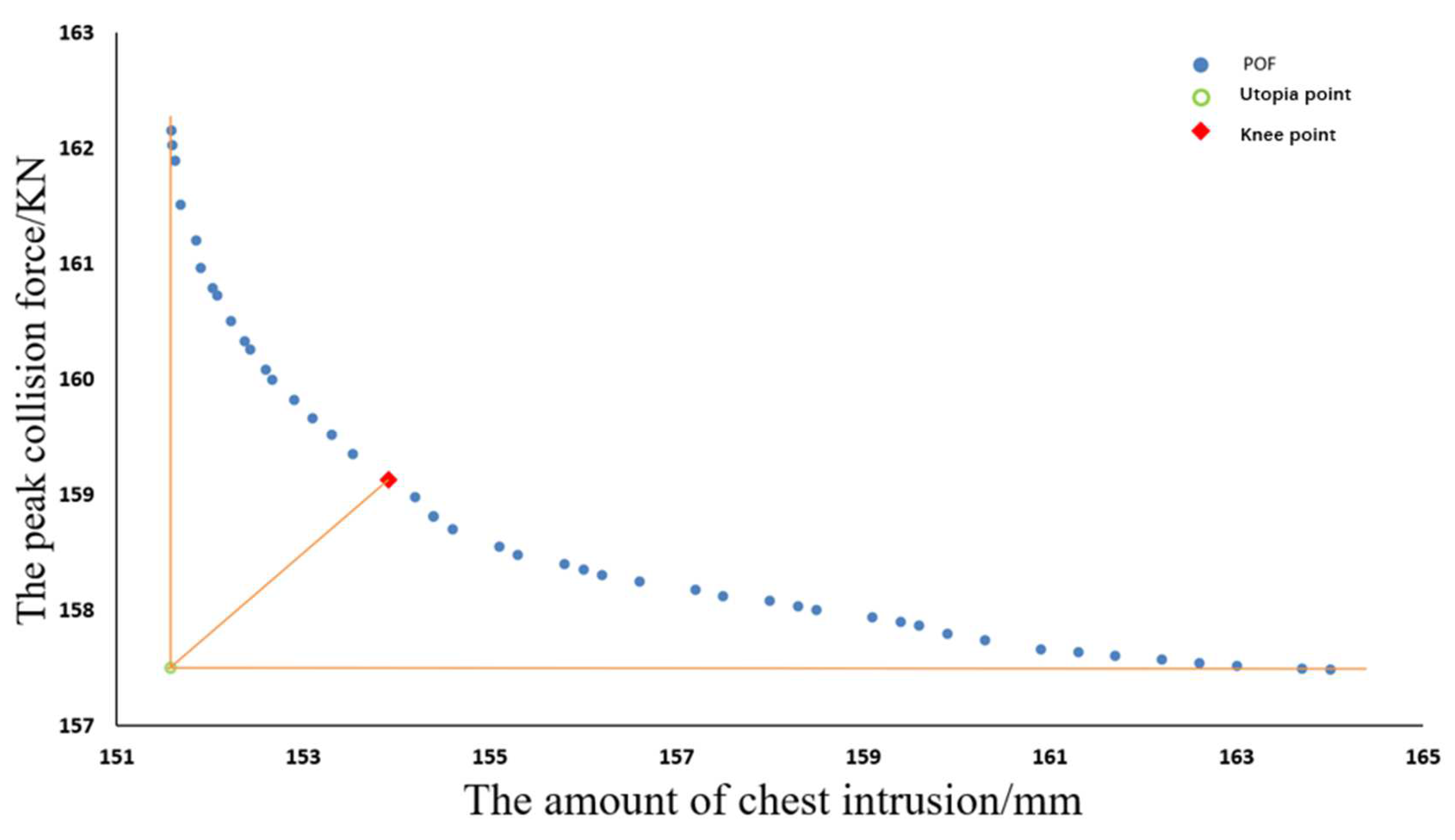
| Basis Function | Mathematical Expression |
|---|---|
| Linear | |
| Cubic | |
| Thin plate | |
| Gaussian | |
| Multi-quadric | |
| Inverse multi-quadric |
| Function | Range of Variable | Function Expression | Features of Front |
|---|---|---|---|
| ZDT1 | [0, 1] | Continuous convex | |
| ZFDT2 | [0, 1] | Continuous concave | |
| ZDT3 | [0, 1] | Discontinuous |
| Number | |||||||
|---|---|---|---|---|---|---|---|
| 1 | 1.66 | 0.84 | 1.66 | 0.83 | 1.32 | 161,732 | 152.144 |
| 2 | 1.45 | 1.03 | 1.82 | 0.62 | 1.10 | 163,497 | 153.255 |
| 3 | 1.82 | 1.35 | 1.29 | 0.56 | 1.61 | 159,388 | 162.529 |
| 4 | 1.74 | 1.18 | 1.34 | 0.97 | 1.58 | 157,333 | 157.281 |
| 5 | 1.61 | 0.93 | 1.71 | 0.87 | 1.87 | 160,340 | 156.951 |
| 6 | 1.10 | 1.07 | 1.58 | 0.94 | 1.74 | 160,169 | 160.868 |
| 7 | 1.29 | 1.01 | 1.26 | 0.68 | 1.08 | 159,750 | 154.788 |
| 8 | 1.95 | 1.29 | 1.74 | 0.76 | 1.84 | 158,812 | 158.481 |
| 9 | 1.87 | 1.05 | 1.39 | 0.61 | 1.16 | 162,148 | 153.432 |
| … | … | … | … | … | … | … | … |
| 33 | 1.84 | 1.54 | 1.50 | 0.81 | 1.42 | 157,375 | 154.149 |
| 34 | 1.79 | 1.41 | 1.18 | 0.80 | 1.92 | 157,580 | 163.254 |
| 35 | 1.90 | 1.31 | 1.87 | 0.64 | 1.29 | 158,880 | 155.757 |
| Response Value | RMSE | R2 |
|---|---|---|
| The amount of chest intrusion | 0.1875 | 0.9865 |
| Peak value of collision force | 0.1924 | 0.9737 |
| Parameters | EFM | ARBF-MLPA | EFM after Optimization | Optimal Ratio | |
|---|---|---|---|---|---|
| Designed variables | (mm) | 1.5 | 1.76 | 1.76 | |
| (mm) | 1.2 | 0.93 | 0.93 | ||
| (mm) | 1.5 | 1.12 | 1.12 | ||
| (mm) | 0.75 | 0.86 | 0.86 | ||
| (mm) | 1.5 | 1.20 | 1.20 | ||
| Response value | (mm) | 161.45 | 154.48 | 152.12 | −4.32% |
| Error | \ | 1.53% | |||
| (KN) | 161.50 | 158.10 | 152.12 | −2.11% | |
| Error | \ | 3.78% | |||
| (Kg) | 11.67 | 10.03 | 10.03 | −14.05% | |
Publisher’s Note: MDPI stays neutral with regard to jurisdictional claims in published maps and institutional affiliations. |
© 2022 by the authors. Licensee MDPI, Basel, Switzerland. This article is an open access article distributed under the terms and conditions of the Creative Commons Attribution (CC BY) license (https://creativecommons.org/licenses/by/4.0/).
Share and Cite
Gao, D.; Yao, B.; Chang, G.; Li, Q. Multi-Objective Optimization Design of Vehicle Side Crashworthiness Based on Machine Learning Point-Adding Method. Appl. Sci. 2022, 12, 10320. https://doi.org/10.3390/app122010320
Gao D, Yao B, Chang G, Li Q. Multi-Objective Optimization Design of Vehicle Side Crashworthiness Based on Machine Learning Point-Adding Method. Applied Sciences. 2022; 12(20):10320. https://doi.org/10.3390/app122010320
Chicago/Turabian StyleGao, Dawei, Bufan Yao, Gaoshuang Chang, and Qiang Li. 2022. "Multi-Objective Optimization Design of Vehicle Side Crashworthiness Based on Machine Learning Point-Adding Method" Applied Sciences 12, no. 20: 10320. https://doi.org/10.3390/app122010320
APA StyleGao, D., Yao, B., Chang, G., & Li, Q. (2022). Multi-Objective Optimization Design of Vehicle Side Crashworthiness Based on Machine Learning Point-Adding Method. Applied Sciences, 12(20), 10320. https://doi.org/10.3390/app122010320









